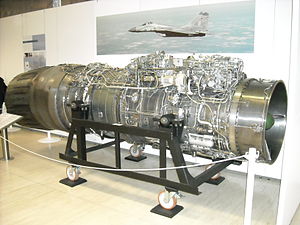The Mikoyan MiG-35 (Russian: Микоян МиГ-35, NATO reporting name: Fulcrum-F) is a further development of the MiG-29M/M2and MiG-29K/KUB technology. It is classified as a 4++ generation jet fighter by Mikoyan.The first prototype was a modification of the aircraft that previously served as MiG-29M2 model demonstrator. 10 prototypes have been built so far and are currently subject to extensive field trials. The MiG-35 is now classed as a medium-weight aircraft because its maximum take-off weight has increased by 30 percent, exceeding its previous criteria of classification.
MiG Corporation first officially presented the MiG-35 internationally during the Aero India 2007 air show. The MiG-35 was officially unveiled when the Russian
| MiG-35 | |
|---|---|
|
| |
| A MiG-35D | |
| Role | Multirole fighter |
| National origin | Russia |
| Manufacturer | Mikoyan |
| First flight | 2007 |
| Status | In Development |
| Number built | 3 known completed by June 2010[1] |
| Developed from | Mikoyan MiG-29M |
Minister of Defence, Sergey Ivanov, visited Lukhovitsky Machine Building Plant "MAPO-MIG".[5] The single seat version is designated MiG-35 and the two-seat version is MiG-35D. The fighter has vastly improved avionics and weapon systems, notably the new AESA radar and the uniquely designed Optical Locator System (OLS), relieves the aircraft from relying on ground-controlled interception (GCI) systems and enables it to conduct independent multi-role missions.
New modifications include the newly rolled-out Phazotron Zhuk-AE active electronically scanned array (AESA) radar and an optronic complex consisting of the newly designed OLS to replace the previous IRST sensor, an additional OLS under the right air intake, and a pair of laser emission detectors on each wing tip.Sensors
 The Phazotron Zhuk-AE AESA radar offers a wider range of operating frequencies, providing more resistance to electronic countermeasures (ECM), more detection range, more air and ground targets detected, tracked and able to be engaged simultaneously. The radar is thought to have detection range of 160 km (86 nmi) for air targets and 300 km (160 nmi) for ships.[18]
The Phazotron Zhuk-AE AESA radar offers a wider range of operating frequencies, providing more resistance to electronic countermeasures (ECM), more detection range, more air and ground targets detected, tracked and able to be engaged simultaneously. The radar is thought to have detection range of 160 km (86 nmi) for air targets and 300 km (160 nmi) for ships.[18]
The OLS, a new development from space technologies, incorporates a helmet-mounted target designation system providing targeting solutions for both ground and air targets in the forward and aft hemispheres of the aircraft. The most vital difference from the previous IRST sensor is that the new device provides not only a better operation range but also offers manually switchable display options of IR view, TV mode or a mix of both that significantly improves man-machine coordination. The OLS on the nose serves as the IRST while the OLS under the right air intake serves as the ground strike designator.
In air combat, the optronic suite allows:
- Detection of non-afterburning targets at 45 km range and more;
- Identification of those targets at 8 to 10 km range; and
- Estimates of aerial target range at up to 15 km.
For ground targets, the suite allows:
- A tank-effective detection range up to 15 km, and aircraft carrier detection at 60 to 80 km;
- Identification of the tank type on the 8 to 10 km range, and of an aircraft carrier at 40 to 60 km; and
- Estimates of ground target range of up to 20 km.
Specifications
- The MiG-35 is currently in development. Information listed below is preliminary and may change.
Data from Mikoyan MiG-29M2 data, Aero India, airforce-technology, deagel.com, and Rian.ru.
General characteristics
- Crew: one or two
- Length: 17.3 m (56 ft 9 in)
- Wingspan: 12 m (39 ft 4 in)
- Height: 4.7 m (15 ft 5 in)
- Wing area: 38 m2 (409 ft2)
- Empty weight: 11,000 kg (24,250 lb)
- Loaded weight: 17,500 kg (38,600 lb)
- Max. takeoff weight: 29,700 kg (65,500 lb)
- Powerplant: 2 × Klimov RD-33MK(right side picture as given) afterburning turbofans
- Dry thrust: 5,400 kgf, 53.0 kN (11,900 lbf) each
- Thrust with afterburner: 9,000 kgf, 88.3 kN (19,800 lbf) each
Performance
- Maximum speed: Mach 2.25 (2,400 km/h, 1,491 mph) at altitude;[21] 1,450 km/h (901 mph) at low-level
- Range: 2,000 km (1,240 mi)
- Combat radius: 1,000 km (620 mi)
- Ferry range: 3,100 km (1,930 mi) with 3 external fuel tanks
- Service ceiling: 17,500 m (57,400 ft)
- Rate of climb: 330 m/s (65,000 ft/min)
- Thrust/weight: 1.14
- Max. maneuvering load factor: 10.0 g
Armament
- Guns: 1× 30 mm GSh-30-1 cannon, 150 rounds
- Hardpoints: 9 total (8× under-wing, 1× centre-line)
- Rockets: S-8, S-13, S-24, S-25L, S-250 unguided and laser-guided rockets
- Missiles:
- Air-to-air:
- AA-10 Alamo: 4× R-27R, R-27T, R-27ER, R-27ET
- AA-8 Aphid: 4× R-60M
- AA-11 Archer: 8× R-73E, R-73M, R-74M
- AA-12 Adder: 8× R-77
- Air-to-surface:
- AS-17 Krypton: 4× Kh-31A, Kh-31P
- AS-14 Kedge: 4× Kh-29T, Kh-29L
- Air-to-air:
- Bombs:
- Guided:
- KAB-500L: 500 kg laser-guided bomb
- KAB-500T: 500 kg TV-guided bomb
- Unguided:
- FAB-250: 250 kg bomb
- FAB-500: 500 kg bomb
- ZAB-500 fuel-air explosive Bomb
- Guided:


Comments
Post a Comment